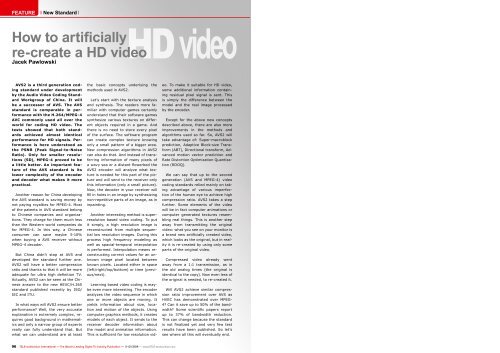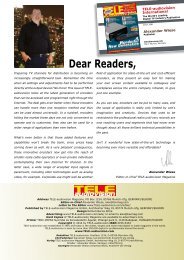AVS2
You also want an ePaper? Increase the reach of your titles
YUMPU automatically turns print PDFs into web optimized ePapers that Google loves.
FEATURE<br />
New Standard<br />
How to artificially<br />
re-create a HD video<br />
Jacek Pawlowski<br />
HD video<br />
<strong>AVS2</strong> is a third generation coding<br />
standard under development<br />
by the Audio Video Coding Standard<br />
Workgroup of China. It will<br />
be a successor of AVS. The AVS<br />
standard is comparable in performance<br />
with the H.264/MPEG-4<br />
AVC commonly used all over the<br />
world for coding HD video. The<br />
tests showed that both standards<br />
achieved almost identical<br />
performance for HD signals. Performance<br />
is here understood as<br />
the PSNR (Peak Signal-to-Noise<br />
Ratio). Only for smaller resolutions<br />
(SD), MPEG-4 proved to be<br />
a little better. An important feature<br />
of the AVS standard is its<br />
lower complexity of the encoder<br />
and decoder what makes it more<br />
practical.<br />
Another reason for China developing<br />
the AVS standard is saving money by<br />
not paying royalties for MPEG-4. Most<br />
of the patents in AVS standard belong<br />
to Chinese companies and organizations.<br />
They charge for them much less<br />
than the Western world companies do<br />
for MPEG-4. In this way, a Chinese<br />
consumer can save maybe 5-10%<br />
when buying a AVS receiver without<br />
MPEG-4 decoder.<br />
But China didn’t stop at AVS and<br />
developed the standard further one.<br />
<strong>AVS2</strong> will have a better compression<br />
ratio and thanks to that it will be more<br />
adequate for ultra high definition TV.<br />
Actually, <strong>AVS2</strong> can be seen at the Chinese<br />
answer to the new HEVC/H.265<br />
standard published recently by ISO/<br />
IEC and ITU.<br />
In what ways will <strong>AVS2</strong> ensure better<br />
performance? Well, the very accurate<br />
explanation is extremely complex, requires<br />
good background in mathematics<br />
and only a narrow group of experts<br />
really can fully understand that. But<br />
what we can understand are at least<br />
the basic concepts underlying the<br />
methods used in <strong>AVS2</strong>.<br />
Let’s start with the texture analysis<br />
and synthesis. The readers more familiar<br />
with computer games certainly<br />
understand that their software games<br />
synthesize various textures on different<br />
objects required in a game. And<br />
there is no need to store every pixel<br />
of the surface. The software program<br />
can create complex texture knowing<br />
only a small pattern of a bigger area.<br />
New compression algorithms in <strong>AVS2</strong><br />
can also do that. And instead of transferring<br />
information of many pixels of<br />
a wavy sea or a distant flowerbed the<br />
<strong>AVS2</strong> encoder will analyze what texture<br />
is needed for this part of the picture<br />
and will send to the receiver only<br />
this information (only a small picture).<br />
Now, the decoder in your receiver will<br />
fill in holes in an image by synthesizing<br />
non-repetitive parts of an image, as in<br />
inpainting.<br />
Another interesting method is superresolution<br />
based video coding. To put<br />
it simply, a high resolution image is<br />
reconstructed from multiple sequential<br />
low resolution images. During this<br />
process high frequency modeling as<br />
well as spacial-temporal interpolation<br />
is performed. Interpolation means reconstructing<br />
correct values for an unknown<br />
image pixel located between<br />
known pixels. Located either in space<br />
(left/right/top/bottom) or time (previous/next).<br />
Learning based video coding is maybe<br />
even more interesting. The encoder<br />
analyzes the video sequence in which<br />
one or more objects are moving. It<br />
yields information about size, location<br />
and motion of the objects. Using<br />
computer graphics methods, it creates<br />
models of each object. It sends to the<br />
receiver decoder information about<br />
the model and animation information.<br />
This is sufficient for low resolution video.<br />
To make it suitable for HD video,<br />
some additional information containing<br />
residual pixel signal is sent. This<br />
is simply the difference between the<br />
model and the real image processed<br />
by the encoder.<br />
Except for the above new concepts<br />
described above, there are also more<br />
improvements in the methods and<br />
algorithms used so far. So, <strong>AVS2</strong> will<br />
take advantage of: Super-macroblock<br />
prediction, Adaptive Block-size Transform<br />
(ABT), Directional transform, Advanced<br />
motion vector prediction and<br />
Rate Distortion Optimization Quantization<br />
(RDOQ).<br />
We can say that up to the second<br />
generation (AVS and MPEG-4) video<br />
coding standards relied mainly on taking<br />
advantage of various imperfection<br />
of the human eye to achieve high<br />
compression ratio. <strong>AVS2</strong> takes a step<br />
further. Some elements of the video<br />
will be in fact computer animations or<br />
computer generated textures resembling<br />
real things. This is another step<br />
away from transmitting the original<br />
video: what you see on your monitor is<br />
a brand new artificially created video,<br />
which looks as the original, but in reality<br />
it is re-created by using only some<br />
parts of the original video.<br />
Compressed video already went<br />
away from a 1:1 transmission, as in<br />
the old analog times (the original is<br />
identical to the copy). Now even less of<br />
the original is needed, to re-created it.<br />
Will <strong>AVS2</strong> achieve similar compression<br />
ratio improvement over AVS as<br />
HVEC has demonstrated over MPEG-<br />
4? Can it save up to 50% of the bandwidth?<br />
Some scientific papers report<br />
up to 37% of bandwidth reduction.<br />
This can change because the standard<br />
is not finalized yet and very few test<br />
results have been published. So let’s<br />
see where all this will eventually end.<br />
96 TELE-audiovision International — The World‘s Leading Digital TV Industry Publication — 11-12/2014 — www.TELE-audiovision.com

















